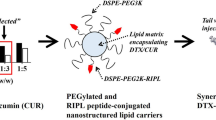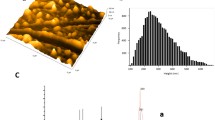Abstract
The present study highlights the beneficial synergistic blend of anticancer drug paclitaxel (PTX) and thymoquinone (TQ) in MCF-7 breast cancer cells. We aimed to augment the therapeutic index of PTX using a polymeric nanoparticle system loaded with PTX and TQ. PLGA nanoparticles encapsulating the two drugs, individually or in combination, were prepared by single emulsion solvent evaporation method. The formulated nanoparticles were homogenous with an overall negative charge and their size ranging between 200 and 300 nm. Entrapment efficiency of PTX and TQ in the dual drug-loaded nanoparticles was found to be 82.4 ± 2.18 and 65.8 ± 0.45 %, respectively. The release kinetics of PTX and TQ from the nanoparticles exhibited a biphasic pattern characterised by an initial burst, followed by a gradual and continuous release. The anticancer activity of nanoparticles encapsulating both the drugs was higher as compared to the free drugs in MCF-7 breast cancer cells. The combination index for the dual drug-loaded NPs was found to be 0.688 which is indicative of synergistic interaction. Thus, here, we propose the synthesis and use of dual drug-loaded TQ and PTX NPs which exhibits enhanced anticancer activity and can additionally help to alleviate the toxic effects of PTX by lowering its effective dose.





Similar content being viewed by others
References
Alam S, Khan ZI, Mustafa G, Kumar M, Islam F, Bhatnagar A, Ahmad FJ (2012) Development and evaluation of thymoquinone-encapsulated chitosan nanoparticles for nose-to-brain targeting: a pharmacoscintigraphic study. Int J Nanomed 7:5705–5718
Ali OAA, Suthama N, Mahfud LD (2014) The effect of feeding black cumin (Nigella sativa) and vitamin C on blood lipid profiles and growth performance of broilers. Int Ref J Eng Sci 3:28–33
Aljabre SH, Randhawa MA, Akhtar N, Alakloby OM, Alqurashi AM, Aldossary A (2005) Antidermatophyte activity of ether extract of Nigella sativa and its active principle, thymoquinone. J Ethnopharmacol 101:116–119
Arafa ESA, Zhu Q, Shah ZI, Wani G, Barakat BM, Racoma I, El-Mahdy MA, Wani AA (2011) Thymoquinone up-regulates PTEN expression and induces apoptosis in doxorubicin-resistant human breast cancer cells. Mutat Res 706:28–35
Attoub S, Sperandio O, Raza H, Arafat K, Al-Salam S, Al Sultan MA, Al Safi M, Takahashi T, Adem A (2012) Thymoquinone as an anticancer agent: evidence from inhibition of cancer cells viability and invasion in vitro and tumor growth in vivo. Fundam Clin Pharmacol 27:1–13
Averineni RK, Shavi GV, Gurram AK, Deshpande PB, Arumugam K, Maliyakkal M, Meka SR, Nayanabhirama U (2012) PLGA 50:50 nanoparticles of paclitaxel: development, in vitro anti-tumor activity in BT-549 cells and in vivo evaluation. Bull Mat Sci 35:319–326
Badary OA, Nagi MN, Al-Shabanah OA, Al-Sawaf HA, Al-Sohaibani MO, Al-Bekairi AM (1997) Thymoquinone ameliorates the nephrotoxicity induced by cisplatin in rodents and potentiates its antitumor activity. Can J Physiol Pharmacol 75:1356–1361
Banerjee S, Kaseb AO, Wang Z, Kong D, Mohammad M, Padhye S, Sarkar FH, Mohammad RM (2009) Antitumor activity of gemcitabine and oxaliplatin is augmented by thymoquinone in pancreatic cancer. Cancer Res 69:5575–5583
Banerjee S, Padhye S, Azmi A, Wang Z, Philip PA, Kucuk O, Sarkar FH, Mohammad RM (2010) Review on molecular and therapeutic potential of thymoquinone in cancer. Nutr Cancer 62:938–946
Banerjee S, Parasramka M, Sarkar FH, Mohammad RM (2012) Molecular insight and preclinical perspective of thymoquinone as chemopreventive agent and therapeutic adjunct in cancer. Nutr Diet Cancer 1:83–107
Bojat V, Balabanyan V, Alyautdin R (2011) The entrapment of paclitaxel in PLGA nanoparticles increases its cytotoxicity against multi-resistant cell line. Br J Med Med Res 1:306–319
Bouquet W, Ceelen W, Adriaens E, Almeida A, Quinten T, De Vos F, Pattyn P, Peeters M, Remon, JP, Vervaet C (2010) In vivo toxicity and bioavailability of Taxol® and a Paclitaxel/β-cyclodextrin formulation in a rat model during HIPEC. Ann Surg Oncol 17:2510–2517
Brannon-Peppas L, Blanchette JO (2004) Nanoparticle and targeted systems for cancer therapy. Adv Drug Deliv Res 56:1649–1659
Chavanpatil MD, Patil Y, Panyam J (2006) Susceptibility of nanoparticle-encapsulated paclitaxel to P-glycoprotein-mediated drug efflux. Int J Pharm 320:150–156
Chou TC (2010) Drug combination studies and their synergy quantification using the Chou-Talalay method. Cancer Res 70:440–446
Danhier F, Lecouturier N, Vroman B, Jerome C (2009) Paclitaxel-loaded PEGylated PLGA-based nanoparticles: in vitro and in vivo evaluation. J Control Release 133:11–17
Devi TSR, Gayathri S (2010) Estimation of paclitaxel drugs by HPLC method. Der Pharma Chemica 2:109–115
El-Mahdy MA, Zhu Q, Wang QE, Wani G, Wani AA (2005) Thymoquinone induces apoptosis through activation of caspase-8 and mitochondrial events in p53-null myeloblastic leukemia HL60 cells. Int J Cancer 117:409–417
El-Najjar N, Chatila M, Moukadem H, Vuorela H, Ocker M, Gandesiri M, Schneider-Stock R, Gali-Muhtasib H (2010) Reactive oxygen species mediate thymoquinone-induced apoptosis and activate ERK and JNK signaling. Apoptosis 15:183–195
Fararh KM, Shimizu Y, Shiina T, Nikami H, Ghanem MM, Takewaki T (2005) Thymoquinone reduces hepatic glucose production in diabetic hamsters. Res Vet Sci 79:219–223
Fonseca C, Simoes S, Gaspar R (2002) Paclitaxel-loaded PLGA nanoparticles: preparation, physicochemical characterization and in vitro anti-tumoral activity. J Control Release 83:273–286
Gali-Muhtasib H, Roessner A, Schneider-Stock R (2006) Thymoquinone: a promising anti-cancer drug from natural sources. Int J Biochem Cell Biol 38:1249–1253
Gali-Muhtasib H et al (2008) Thymoquinone triggers inactivation of the stress response pathway sensor CHEK1 and contributes to apoptosis in colorectal cancer cells. Cancer Res 68:5609–5618
Ganguly A, Cabral F (2011) New insights into mechanisms of resistance to microtubule inhibitors. Biochim Biophys Acta-Rev Cancer 1816:164–171
Ganta S, Amiji M (2009) Coadministration of paclitaxel and curcumin in nanoemulsion formulations to overcome multidrug resistance in tumor cells. Mol Pharm 6:928–939
Govender T, Stolnik S, Garnett MC, Illum L, Davis SS (1999) PLGA nanoparticles prepared by nanoprecipitation: drug loading and release studies of a water soluble drug. J Control Release 57:171–185
Jafri SH, Glass J, Shi R, Zhang S, Prince M, Kleiner-Hancock H (2010) Thymoquinone and cisplatin as a therapeutic combination in lung cancer: in vitro and in vivo. J Exp Clin Cancer Res 29:2285–2296
Kaur J, Tikoo K (2013) p300/CBP Dependent hyperacetylation of histones potentiates anticancer activity of gefitinib nanoparticles. Biochimica Biophysica Acta-Mol Cell Res 1833:1028–1040
Kesarwani K, Gupta R (2013) Bioavailability enhancers of herbal origin: an overview Asian Pacific. J Trop Biomed 3:253–266
Kim SC, Kim DW, Shim YH, Bang JS, Oh HS, Kim SW, Seo MH (2001) In vivo evaluation of polymeric micellar paclitaxel formulation: toxicity and efficacy. J Control Release 72:191–202
Lee MK, Lim SJ, Kim CK (2007) Preparation, characterization and in vitro cytotoxicity of paclitaxel-loaded sterically stabilized solid lipid nanoparticles. Biomaterials 28:2137–2146
Lei X, Lv X, Liu M, Yang Z, Ji M, Guo X, Dong W (2012) Thymoquinone inhibits growth and augments 5-fluorouracil-induced apoptosis in gastric cancer cells both in vitro and in vivo. Biochem Biophys Res Commun 417:864–868
Li F et al (2009) Anti-tumor activity of paclitaxel-loaded chitosan nanoparticles: an in vitro study. Mater Sci Eng 29:2392–2397
Liggins RT, Burt HM (2004) Paclitaxel loaded poly (l-lactic acid) (PLLA) microspheres: II. The effect of processing parameters on microsphere morphology and drug release kinetics. Int J Pharm 281:103–106
Misra R, Sahoo SK (2011) Coformulation of doxorubicin and curcumin in poly (d, l-lactide-co-glycolide) nanoparticles suppresses the development of multidrug resistance in K562 cells. Mol Pharm 8:852–866
Mu L, Feng SS (2003) PLGA/TPGS nanoparticles for controlled release of paclitaxel: effects of the emulsifier and drug loading ratio. Pharm Res 20:1864–1872
Odeh F, Ismail SI, Abu-Dahab R, Mahmoud IS, Al Bawab A (2012) Thymoquinone in liposomes: a study of loading efficiency and biological activity towards breast cancer. Drug Deliv 19:371–377
Parveen S, Misra R, Sahoo SK (2012) Nanoparticles: a boon to drug delivery, therapeutics, diagnostics and imaging. Nanomedicine 8:147–166
Pegram MD, Konecny GE, O’Callaghan C, Beryt M, Pietras R, Slamon DJ (2004) Rational combinations of trastuzumab with chemotherapeutic drugs used in the treatment of breast cancer. J Natl Cancer Inst 96:739–749
Ravindran J, Nair HB, Sung B, Prasad S, Tekmal RR, Aggarwal BB (2011) Thymoquinone poly (lactide-co-glycolide) nanoparticles exhibit enhanced anti-proliferative, anti-inflammatory, and chemosensitization potential. Biochem Pharmacol 79:1640–1647
Rowinsky EK, Eisenhauer EA, Chaudhry V, Arbuck SG, Donehower RC (1993) Clinical toxicities encountered with paclitaxel (Taxol). Semin Oncol 20:1–15
Ruan G, Feng S-S (2003) Preparation and characterization of poly (lactic acid)-poly (ethylene glycol)-poly (lactic acid) (PLA-PEG-PLA) microspheres for controlled release of paclitaxel. Biomaterials 24:5037–5044
Sethi G, Ahn KS, Aggarwal BB (2008) Targeting nuclear factor-kB activation pathway by thymoquinone: role in suppression of antiapoptotic gene products and enhancement of apoptosis. Mol Cancer Res 6:1059–1070
Singh A, Ahmad I, Akhter S, Jain GK, Iqbal Z, Talegaonkar S, Ahmad FJ (2012) Nanocarrier based formulation of Thymoquinone improves oral delivery: stability assessment, in vitro and in vivo studies. Coll Surf B 102:822–832
Singla AK, Garg A, Aggarwal D (2002) Paclitaxel and its formulations. Int J Pharm 235:179–192
Surapaneni MS, Das SK, Das NG (2012) Designing paclitaxel drug delivery systems aimed at improved patient outcomes: current status and challenges. ISRN Pharmacol 2012:1–15
Takeda M, Mizokami A, Mamiya K, Li YQ, Zhang J, Keller ET, Namiki M (2007) The establishment of two paclitaxel-resistant prostate cancer cell lines and the mechanisms of paclitaxel resistance with two cell lines. Prostate 67:955–967
Tiwari SB, Amiji MM (2006) Improved oral delivery of paclitaxel following administration in nanoemulsion formulations. J Nanosci Nanotechnol 6:3215–3221
Vicari L, Musumeci T, Giannone I, Adamo L, Conticello C, De Maria R, Pignatello R, Puglisi G, Gulisano M (2008) Paclitaxel loading in PLGA nanospheres affected the in vitro drug cell accumulation and antiproliferative activity. BMC Cancer 8:212–223
Wang AZ, Langer R, Farokhzad OC (2012) Nanoparticle delivery of cancer drugs. Ann Rev Med 63:185–198
Wang G, Yu B, Wu Y, Huang B, Yuan Y, Liu CS (2013) Controlled preparation and antitumor efficacy of vitamin E TPGS-functionalized PLGA nanoparticles for delivery of paclitaxel. Int J Pharm 446:24–33
Woo CC, Loo SY, Gee V, Yap CW, Sethi G, Kumar AP, Benny Tan KH (2011) Anticancer activity of thymoquinone in breast cancer cells: possible involvement of PPAR-Y pathway. Biochem Pharmacol 82:464–475
Woo CC, Kumar AP, Sethi G, Tan KHB (2012) Thymoquinone: potential cure for inflammatory disorders and cancer. Biochem Pharmacol 83:443–451
Yi T, Cho SG, Yi Z, Pang X, Rodriguez M, Wang Y, Sethi G, Aggarwal BB, Liu M (2008) Thymoquinone inhibits tumor angiogenesis and tumor growth through suppressing AKT and extracellular signal-regulated kinase signaling pathways. Mol Cancer Ther 7:1789–1796
Zhao L, Au JL, Wientjes MG (2010) Comparison of methods for evaluating drug-drug interaction. Front Biosci 2:241–249
Zuo KQ, Zhang XP, Zou J, Li D, Lv ZW (2010) Establishment of a paclitaxel resistant human breast cancer cell strain (MCF-7/Taxol) and intracellular paclitaxel binding protein analysis. J Int Med Res 38:1428–1435
Acknowledgments
The research work was supported by funds granted by National Institute of Pharmaceutical Education and Research, S.A.S. Nagar, Punjab, India.
Authors contributions
PS designed and performed the experiments and drafted the manuscript, JK designed the experiments and drafted the manuscript and KBT supervised and approved the final version of manuscript.
Conflict of interest
None.
Author information
Authors and Affiliations
Corresponding author
Rights and permissions
About this article
Cite this article
Soni, P., Kaur, J. & Tikoo, K. Dual drug-loaded paclitaxel–thymoquinone nanoparticles for effective breast cancer therapy. J Nanopart Res 17, 18 (2015). https://doi.org/10.1007/s11051-014-2821-4
Received:
Accepted:
Published:
DOI: https://doi.org/10.1007/s11051-014-2821-4




